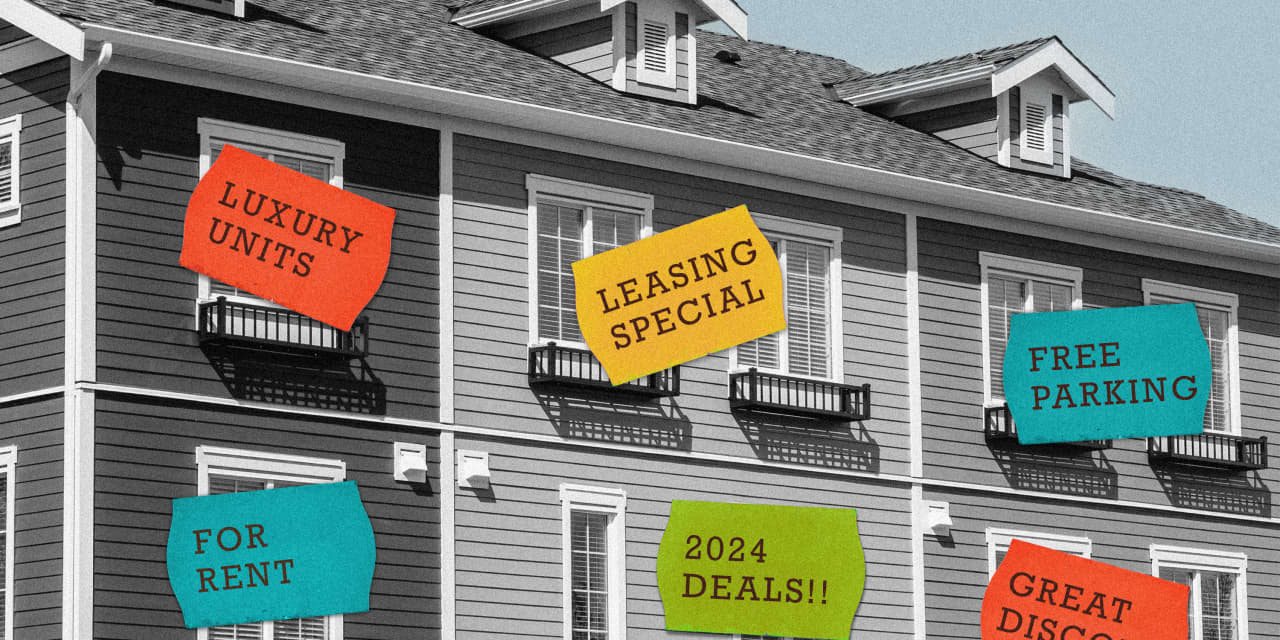There’s a good reason prospective first-time home buyers might keep renting in 2024, even as mortgage rates come down: a surge of rental housing hitting the market will bring more choice—and incentives.
High costs have called into question homeownership’s status as a cornerstone of the American dream. Economists say that first-time buyers could continue to rent for longer, and opt for a larger apartment or single-family rental instead of a starter home.
A shift in preferences may be under way—but there’s a more immediate financial reason to consider renting over buying. More large multifamily construction projects were completed in the first 10 months of 2023 than any comparable period since 1987. The surge in new units follows a spike in multifamily housing starts in 2021 and 2022.
As of October, 361,000 such units have been completed this year, census data show. That’s helped soften rents: The median national rent gauged by ApartmentList in November was 1.1% lower than one year prior, with rents in cities such as Austin, Portland, San Francisco, Phoenix, and Atlanta having fallen even more dramatically.
There’s more supply on the way: Jay Lybik,
CoStar’s
national director of multifamily analytics, expects that there will be 450,000 new multifamily deliveries in the new year. That means more options for renters—not to mention continuing discounts and incentives. “If you can’t buy right now, it’s really not a bad time to have to continue to rent,” Lybik says—at least if you’re a renter shopping in higher price tiers.
The influx of new units means deals abound for a very specific type of renter: “For households that are renting at the luxury level, this creates a situation in which—while they may not be able to buy—their rents most likely won’t be going up,” Lybik says. CoStar data show that more than a fourth of multifamily rental properties in October offered a concession of some sort, such as a period of free rent or fee waivers—the largest share since late 2020.
Should such households choose to move, they could even pay less through concessions offered by new buildings aiming to lease up, Lybik says. That could be particularly salient for renters in places where apartment deliveries are well above their typical levels. Markets in the Sunbelt, such as Phoenix, Tampa, and Austin, are among those seeing the most new supply relative to their norms, Lybik says.
In October, incentives were most frequent in Phoenix, Austin, and Minneapolis, according to a CoStar analysis of the top 20 markets by existing multifamily inventory. Renters in Detroit, Boston, and Orange County, Calif.; saw the fewest.
The tight for-sale housing market has kept demand for such rental stock relatively strong as would-be buyers opt to rent, says Lu Chen, senior economist at Moody’s Analytics.
Another area that could capture demand from priced-out buyers: single-family rentals. Two residential real estate technology companies recently released 2024 forecasts nodding to growing demand for single-family rentals. “The new starter home will be a single-family rental,”
Zillow
wrote in a 2024 forecast published late last month.
Redfin
said similar: “Demand for large rental apartments and houses will climb as more young families embrace the renter lifestyle,” the brokerage and home-listings company wrote in a report last week. “We’re already seeing signs that young people are redefining the American dream.”
Investors are drawn to single-family rentals because of the asset class’s relative stability, says Rick Palacios, Jr., the director of research at real estate data firm John Burns Research and Consulting.
Rents in these units typically grow at the same pace of overall inflation and wages—and new rental listings diluting supply typically isn’t a concern. “One of the reasons that people like this industry is because it’s typically pretty hard to get a big tsunami of supply coming into the system,” he says. There are about 14.6 million single-family rentals in the U.S., Palacios says, up from about 11 million in the mid-aughts but below the post-recession peak of roughly 15.5 million.
But investors hit pause in the space as the cost of capital rose, notes Palacios. Investment will likely pick back up if rates come down in 2024 and the U.S. avoids a recession, he says—but, for many investors, it’s too soon to make a move. After all, single-family investors face the same headwinds as home buyers more broadly.
“You could probably count on one hand how many markets across the country have actually come down double digits on price,” he says.
While affluent renters continue to embrace multifamily rentals, lower-income renters are feeling squeezed, says Moody’s Analytics’ Chen. “We are seeing affordability really taking a toll on this part of the renter household,” she says, citing the impact of inflation and the resumption of student loan payments.
As a result, some renters in this tier are moving in with roommates or back home with their parents, Chen says, thinning demand for lower cost rentals, referred to as class B and C.
Rents will likely grow less than normal in 2024 in part because of the continuing flow of new multifamily supply. Investors might not find much to like in multifamily right now, particularly in markets with a lot of new supply. But it could pay to be patient and picky, Chen says.
Residential construction has begun to shift back to single-family homes, Chen notes. That means after the new units planned during the recent multifamily boom become available, multifamily supply will grow very slowly. “If investors can just hold on to the new supply for just a little longer, after ’25 to ’26, we are seeing a restructuring in demand in the multifamily market, and that is really promising,” she says.
Investors should focus on areas with good economic growth prospects. Despite the near-term supply glut, markets like Washington, and Minneapolis are primed for rent growth in the coming years as more households seek job opportunities and relative affordability, she says.
Write to Shaina Mishkin at [email protected]
Read the full article here




